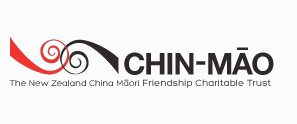
The Land of the Long White Cloud — Notes on My Visit to New Zealand By Wang Hong
Pictured Above: Editor-in-Chief, Wang Hong with Maori host, Robyn Tauroa
In China, when people talk about New Zealand, the first things that come to mind are clear blue skies, fresh air and high-quality dairy products. For us, working in the Chinese People’s Association for Friendship with Foreign Countries, New Zealand has a special appeal, for it is the homeland of the late Rewi Alley (1897-1987)*, an old friend of the Chinese people who did so much for the construction and development of China and made important contributions to developing the friendship between the two countries. He lived in the CPAFFC compound from 1958 until his death.
Invited by the Maori-China Friendship Association, a CPAFFC delegation paid a 10-day friendly visit to New Zealand last November. I was fortunate to be a member. With profound memory of our old friend Rewi, I had much expectation of the visit to his homeland.
Learning About the History and Culture of the Maori People
It was the first visit to New Zealand for most members of the delegation. Everything we saw and heard was new. We had our first taste of the Maori culture when we visited the Maori schools—Te Kura Kaupapa Motuhake o Tawhiuau and Te Kura of Hirangi. The teachers and students received us with formal welcome ceremonies which began with chanting, followed by welcome speeches in the Maori language and ended with hongi (the traditional Maori greeting done by pressing noses and foreheads together). The students also put on shows of Maori dances and songs.
At Te Kura Kaupapa Motuhake o Tawhiuau, school principal Pem Bird gave a brief account of the Maori history. There are 55 Maori tribes in New Zealand claiming Polynesian origin. Having braved strong winds and high waves and overcome numerous difficulties and dangers, their ancestors arrived in New Zealand in canoes from Hawaiki about 1,000 years ago. The tribes divided the land into separate territories over which they exercised sovereignty, although they also forged inter-tribal alliances as time past.
The Maoris were mainly engaged in agriculture, although some lived on fishing, hunting and gathering. They had a very well developed handicraft industry.
In the early 19th century, more and more British settlers traveled to New Zealand. They seized land from the Maoris, triggering wars. In 1840, after the Treaty of Waitangi was signed, the country became a British colony.
The impact of colonization was devastating. The Maori population decreased dramatically, almost to the point of extinction. Not until the country became independent in 1907 were the rights of the Maori people respected, and its population began to grow again. Influenced by the British New Zealanders, changes have taken place in the Maori society. The Maori people today speak English and many of them work in cities. They have a growing sense of identity and their culture has been revived. This is why the primitive sacrificial ritual dances have become traditional art forms, showing the unique cultural charm of New Zealand.
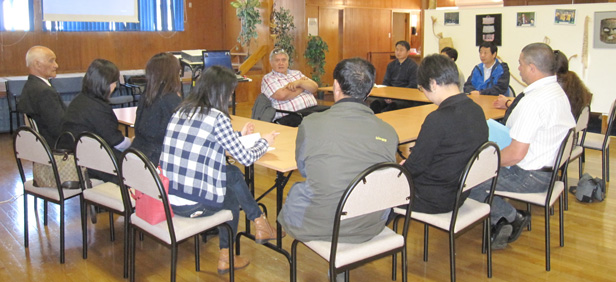
Above: Principal, Pem Bird giving us an introduction to Maori history and his school, Te Kura Kaupapa Motuhake o Tawhiuau
At the Waitetoko Marae in Turangi, we were greeted with a formal ceremony featuring a challenge, speeches, songs and hongi. Being treated as distinguished guests, we were put up in the marae, the tribe’s sacred meetinghouse where their ancestors’ spirits are enshrined and where all ceremonies are held and decisions concerning the tribe are made.
When I entered the marae, I saw the inside walls were decorated with painted planks hung with pictures of tribal leaders and woven panels. Along one side, mattresses were placed on the floor. Our considerate hosts had prepared everything—mattresses, pillows, quilts and blankets and even electric heaters—for us.
As outsiders, it was a great honor to live in the marae, but we all felt somewhat embarrassed as male and female members would spend the night under the same roof. After two days’ stay, I had a different feeling and began to understand the intimate relationship among the Maori people. In their primitive tribal life, they had depended on each other and worked together to survive. This creates firm trust and is also the source of their sincere friendship for their Chinese friends. Having experienced it, I valued it all the more.
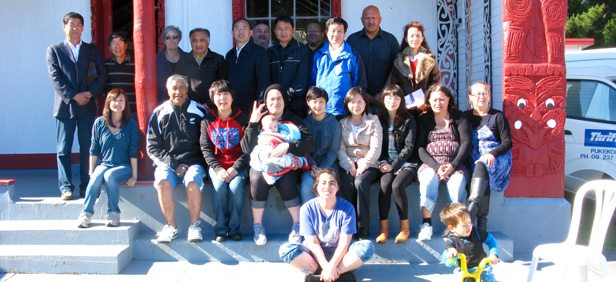
The delegation with Ngati Tuwharetoa elders and other Maori friends at Waitetoko Marae, Taupo
The Maori people pay great attention to education, which is an important guarantee for their cultural tradition to continue. At the Maori schools we visited we learnt that all classes are taught in the Maori language. The schools can make their own curricula and adopt the teaching methods of their choice. Children study the Maori language, history, cultural tradition and science, learn to respect older people and nature as well as production skills such as raising pigs, growing vegetables, etc.
Though the Maori people occupy only 14 % of the total population of New Zealand, they have well protected their unique culture through basic education so that traditional arts including moko (tattoo), haka (dance) and powhiri (formal welcome) will pass on generation after generation.

Pictured Above: Pupils at Te Kura o Hirangi performing Maori dance for our delegation
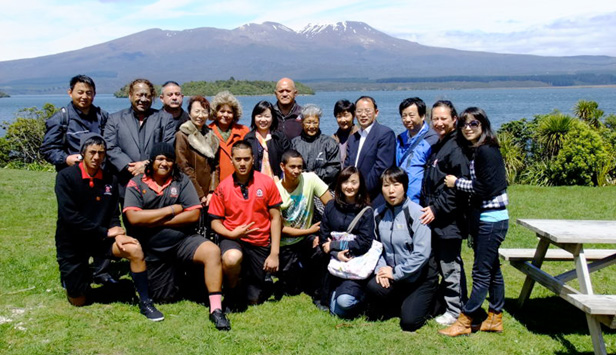
Pictured Above: The delegation at Opotaka, the birthplace of Ka mate, Ka mate. The young men in the photo performed the haka for us!
“Ka mate! Ka mate! Ka ora! Ka ora!” the sonorous cries resounded at Opotaka, the sacred birthplace of the Haka (well known to rugby fans around the world as it is performed by the national team, the All Blacks, before every match). Four Maori students from Te Kura O Hirangi were performing Haka on the grassland by the lake against the background of snow-capped mountains in the distance.
They did not wear tattoos or the usual outfits for the dance, but their high-spirited and earnest acting still enabled us to see the valiant tribal warriors of those days ready to go to battles. This time they performed Haka not to arouse fighting morale, but to familiarize us with their culture.
Friends of Nature
The Maori people’s attitude towards nature is admirable. They own fertile land, mountains and rivers, but they have never overused them. They treasure everything around them. “Our ancestors sailed to New Zealand in canoes after going through numerous difficulties. They opened up the land to seek food for Maori people and to receive friends. We do not own the land. We are only caretakers. It is our duty to protect this land for our children and grandchildren.” These words of an elder of the tribe reflected the Maori people’s respect for nature and their profound love for the land that has nurtured their ancestors and will nurture their posterity.
It is because of their understanding of the relationship between man and environment that they have always used everything the land offers sparingly; it is because of their persistence and perseverance that New Zealand today still has blue skies, green mountains, clear waters and fresh air.
The Maori Hospitality
We toured Auckland, Rotorua, Murupara, Taupo, Wellington and Christchurch and visited Maori tribes, Maori schools, cultural centers, farms, museums, a brewery and a winery during our 10-day stay. We lived in close friendship with our Maori friends throughout the trip. Our home stay experience in Auckland enabled us to make friends and learn about the Maori family life. At Maori schools, we were impressed by Maori children’s enthusiastic performances of traditional Maori songs and dances.
At Waitetoko Marae, we were feasted with all the delicacies the land could produce such as eel, trout, beef, lamb, oyster, water cress, etc. and became intoxicated in the songs and dances we performed for each other to express our feelings. In Christchurch we gathered together with friends from the New Zealand-China Friendship Society and enjoyed the potluck dinner they prepared.

Maori friends see the delegation leave at Christchurch Airport
The humorous Danny Tauroa became our “driver” who took us safely all the way from one end of North Island (Auckland) to the other (Wellington), in addition to his many roles including “tour manager”, escort, etc. The joyous and warm-hearted Robyn Tauroa who accompanied us throughout our visit in North Island taught us Maori songs and our drive on the road was filled with songs and laughter.
Continuing the friendship
I remember at the Rewi Alley Park, we bowed before his bust to express our respect for him. He would be happy to know that the seeds of friendship between China and New Zealand he had sowed have now grown into tall trees and blossomed. We pledged we would continue to cultivate the friendship between China and New Zealand so that it would bear rich fruit.
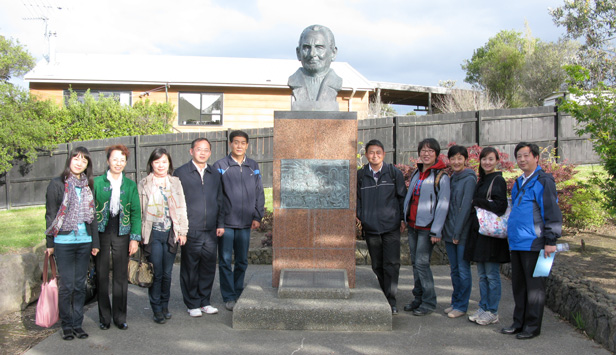
The delegation paying respects to Rewi Alley at Rewi Alley Park in Auckland, NZ
*Rewi Alley, a New Zealander, came to China in 1927. Sharing wealth and woe with the Chinese people, he devoted 60 years of his life to Chinese people’s cause of liberation and construction. In the 1930s, he joined an international Marxist-Leninist group in Shanghai and wrote many articles publicizing the Chinese people’s resistance against Japanese aggressors. During the War of Resistance against Japanese Aggression, he took an active part in and was one of the sponsors of the Chinese Industrial Cooperative Movement that became a unique economic force that emerged by organizing the unemployed workers and refugees into production and survival and in support of the Resistance War. After the founding of New China, he dedicated his efforts to safeguard world peace and the cause of friendship among the peoples of the world, making important contributions to developing friendship between the Chinese people and the people of New Zealand and other countries.


